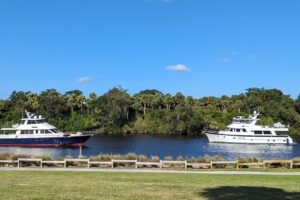After a couple of days in Munising, we drove west to Marquette and checked into Marquette Tourist Park, a nice city park. We visited the Marquette Regional History Center. We learned so much about the history of and current life in the UP that we decided we were honorary Yoopers. This is a town we’d like to come back to. It even had a Starbucks close to the university, but we had too much to do to go there.

While we’re been traveling in Michigan, we’ve enjoyed learning about the life saving service that in 1915 evolved into the Coast Guard. The reason for the change came from radar being installed on ships so men could see other ships in the fog and avoid the frequent crashes. The other reason for the change is that the tankers carrying the heavy loads had traveling lanes that were farther out in Lake Superior and so weren’t so close to land where they could crash into rocks.
One of the ways the life-saving service saved those on sinking ships was to shoot a rope from a cannon over the top of the ship with a seat to carry people over the waves. A person would get into the seat and be pulled to shore. Then the seat would be pulled back to the ship, and another person would come to shore.
Yesterday we went to the Marquette Maritime Museum and saw a display of the last time the cannon was used to shoot a rope for recovering the survivors on the ship The Maryland. This was also the first time a helicopter was used during the same rescue.

wreck of the MARYLAND
On September 12, 1953, life-saving history was made.

Using the centuries old breeches buoy method, the Marquette Station Crew rescued 24 of the MARYLAND’S crew from the forward part of the ship.

The following painting highlights the rescue transitions.

Look at all of the shipwrecks that have happened on Lake Superior. Amazing!

The museum also had an example of the first diver’s suit.

This diving suit, also called a “Hard Hat” rig, was manufactured in late 1939 or early 1940.

The volume of air required a heavy weight to hold the drive down: helmet weighs 54 lbs., each shoe weights around 17 lbs., and chest weight belt is 60 lbs. In total, the diving suit could weigh 190 lbs. Underneath the suit the diver wore heavy, warm clothing so he could work underwater for hours.
The museum also had a display of the changes in underwater cameras that have been used.

This museum is really close to a lighthouse that used to guide ships coming into harbor. They’ve fairly recently recovered the beautiful and intricate lens that had been stored away in a Coast Guard location on the east coast for many years.


One of the displays we really appreciated was about the pocket docks used to store iron ore, etc., and then fill freighters. If you remember, we talked about these freighters in the Sault Ste. Marie bulk carrier museum post. Train cars from the mines would empty their iron ore (or other loads) into the “pockets” on the docks. The hoppers would open, and the load would tumble down the chutes to fill up the carriers, making sure that the ore was emptied in a specified order so the load would be balanced. In the Maritime Museum in Marquette, we saw pictures of how this happened.


Later on in town we saw an actual pocket dock along the harbor. It was no longer in use because the bulk carriers became too big for such “small” docks.



Finally at the museum, we saw models of what the Edmund Fitzgerald would have looked like before and after it sank.






